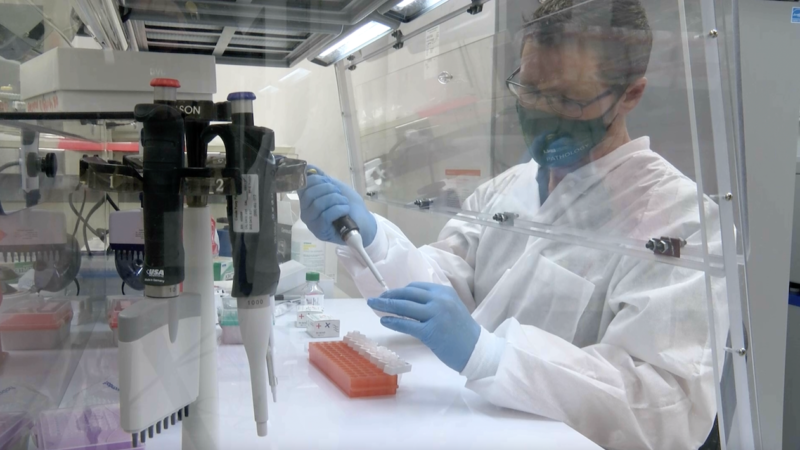How did the newt cross the road? With the help of the Chileno Valley Newt Brigade!
Sally Gale is a rancher in rural west Marin County, California. In addition to raising beef cattle, she leads a specialized brigade — one that’s helped save thousands of amphibians. The amphibians are Pacific newts and they’re a type of salamander that, herpetologically speaking, is awfully cute.
Snout to tail, they’re about six inches long, a rich reddish brown on top with a bright orange underbelly.
“They have cute little eyes that kind of bug out. They kind of look like a cartoon character,” Gale says.
But they’re very slow movers and for this otherwise healthy population of newts about 50 miles north of San Francisco, that spells trouble.

Starting in late fall each year, migrating newts have to cross a public road that divides their forested hillside habitat from their spawning ground in a nearby Laguna Lake, a shallow body of water that abuts Chileno Valley Road.
This population of newts isn’t on any endangered or threatened species lists and Gale says she and her group are working to keep it that way.
So when pickup trucks and cars come zipping along this mile-long stretch of the road — on average about 30 every hour — many newts get squashed. For Gale, whose ranch is a couple miles away from the lake, witnessing the loss was too much.
“That’s really what got me started,” Gale says. “I couldn’t stand seeing all those dead animals.”
With help from a close friend, she launched the Chileno Valley Newt Brigade. Now about 80 volunteers strong, the grassroots group has for six years rescued more than 22,300 Pacific newts — the California and Rough-skinned varieties — and a host of other nocturnal creatures.
A team of about 10 brigadiers is assigned to each night of the week during migratory season, which typically spans late fall through March.
Suited up with reflective safety vests, high-powered flashlights and walkie-talkies that allow team members to communicate along this mostly dead cell zone, the brigadiers patrol the migratory mile.
Some trek solo, others work together, their flashlights sweeping the ground in front of them as they search for and ferry to safety anything trying to crawl, wiggle or hop across the road.
Starting in late fall, baby newts, that morphed from legless tadpoles with gills and fins, leave the lake and head to the hills. They’ll spend the next five years in the moist forest maturing before returning to spawn.
“They do this in the water and lay their eggs,” says brigadier Craig Erridge. “The eggs develop the little tadpoles and the little efts or baby newts, hang out in the marshes until the rainy season when they head up toward the hills.”
Crossing in the opposite direction as the babies: adults heading to breed at the lake. The males typically head out before the females. Some are larger than average, like one hefty male that catches the attention of Erridge and fellow brigadiers Lauren Cole, Kiley Dell’Amico and Jason Frank.
“Look at that chunk,” Dell’amico laughs as Erridge photographs the big fella.
“He’s well-fed!” agrees Cole.
“That’s a newt with a capital N!” Frank says to laughter.
It’s moments like these, the volunteers say, that help offset the sadness they feel when they come upon dead newts they couldn’t rescue. The brigadiers document every one — dead or alive — with photos and location data they upload to the citizen science app, iNaturalist.
Gary Bucciarelli, a wildlife biologist with the University of California at Davis, applauds the brigade’s work. He says humans have a lot to learn from newts.
“They’re an incredible species, “Bucciarelli says.
When injured, research shows newts can repeatedly, and throughout their entire lives, regenerate tissue, organs and fully functional body parts, such as limbs, tails and eyes.
“It’s mind-blowing right?” says Bucciarelli. “Then also they live really long – they can live 20 to 30 years, easily.”
He says it’s quite likely they may even live longer, especially when they don’t get run over. But even when that happens, it’s not always fatal. Their regenerative abilities and the presence of the brigadiers give injured newts a chance to survive. Included among the lucky ones, another male with bloodied, partially severed tail that Cindy Meiswinkel and Sohni Yayalian found stunned in the road.
“If it’s just the tail he can regenerate it,” Yayalian tells Meiswinkel. The two women take a few moments to examine and then document the newt before the next vehicle speeds by. The little guy appears to have no other injuries.
“You’re all right, Bubba, you’re okay,” Meiswinkel coos as Yaylian gently scoops him up and moves him to the grass on the side of the road nearest the lake.
“We’ll hope for the best,” Yaylian says, setting him down, pointing in the same direction he was traveling.
The GPS and other data collected each night is helping inform a study the Newt Brigade has commissioned with financial help from a roughly $75,000 California Department of Fish and Wildlife grant it received in 2023 to examine road modifications that may one day provide the newts and other small creatures safe migratory passage.
Gale says the group has used the money to hire a biologist and engineer who are studying their location data, in particular.
“They’re looking at the road and they’re coming up with a plan that can be presented to the county, kind of a recommendation on what to do to save the newts from getting run over, Gale says.
She expects they’ll recommend some type of under-road culvert or tunnel to safely link the habitat zones along the heaviest traveled portions of that migratory mile.
But until then, Sally Gale says, the Chileno Valley Newt Brigade will remain on patrol every night escorting newts, frogs, toads and turtles safely across the road.
Transcript:
ARI SHAPIRO, HOST:
In coastal northern California, a group of volunteers spends every night – from late fall through winter – as crossing guards. Not for children – they are escorting migrating salamanders across a rural road. Their goal is to win a permanent safe passage for these little amphibians. Reporter Stephanie O’Neill has the story.
STEPHANIE O’NEILL, BYLINE: Sally Gale is a Marin County rancher who’s helped save thousands of Pacific newts – a type of salamander that, herpetologically speaking, is awfully cute. Snout to tail, they’re about 6 to 8″ long. They’re a rich, reddish brown on top with a bright orange underbelly and, says Gale…
SALLY GALE: They have cute little eyes that kind of bug out. They kind of look like a cartoon character.
O’NEILL: But newts are slow movers, and for this otherwise healthy population of them here in Marin County’s Chileno Valley – about 50 miles north of San Francisco – that spells trouble. Starting in late fall each year, these nocturnal migrators must cross a public road that divides their forested hillside habitat from their spawning ground at a nearby shallow lake. And at night, when pickup trucks and cars come zipping along this mile-long stretch of the road…
(SOUNDBITE OF CAR DRIVING PAST)
O’NEILL: …Many of the newts get squashed. For Gale, whose ranch is a couple miles away from the lake, seeing so many dead newts on the road was just too much.
GALE: And that’s really what got me started. I couldn’t stand seeing all those dead animals.
O’NEILL: So six years ago, with help from a close friend, she launched the Chileno Valley Newt Brigade.
GALE: How’s it going, people?
UNIDENTIFIED MEMBER #1: Good, you?
UNIDENTIFIED MEMBER #2: I saw, I think, three adults.
GALE: Ooh.
(CROSSTALK)
UNIDENTIFIED MEMBER #2: And two babies.
O’NEILL: Now about 80 strong, the grassroots group has to date carried to safety more than 22,000 Pacific newts and a host of other nocturnal amphibians and reptiles.
CHRISTINE: Does somebody have a radio? This is Christine, over.
SOHNI YAYLIAN: I have one, Christine. This is Sohni, over.
O’NEILL: Suited up with walkie talkies, high-powered flashlights and wearing reflective vests to keep themselves safe from cars, the brigadiers patrol the migratory mile – a team of about 10 assigned to each night of the week. Some trek solo, others work together, flashlights sweeping the ground in front of them as they search for and ferry to safety anything trying to crawl, wiggle or hop across the road.
CRAIG: Yeah, I got, like…
LAUREN: See a newt?
CRAIG: …Eighteen on that end. I don’t remember what everybody else has got, but there’s, like…
O’NEILL: On this night, baby newts that just a while ago were legless tadpoles with gills and fins leave the lake and head to the hills. They’ll spend the next five years in the moist forest maturing before returning to spawn. And crossing in the opposite direction, adults heading to breed at the lake, like this hefty guy.
CRAIG: He’s big.
LAUREN: He’s big.
KILEY: Look at that chunk.
(LAUGHTER)
LAUREN: He’s well-fed.
(LAUGHTER)
O’NEILL: Each rescue is documented with a photo and information about the newt the team uploads to the citizen science app iNaturalist.
Gary Buciarelli is a wildlife biologist with the University of California at Davis. He applauds the brigades’ work and says humans can learn a lot from newts. Among their most notable superpowers, they can regenerate fully functional limbs, organs and tissue whenever injured.
GARY BUCCIARELLI: And then, also, they live really long. A lot of people don’t know this, but these newts can live 20, 30 years, easily.
O’NEILL: And perhaps much longer, Bucciarelli says, especially if they don’t get mowed down.
LAUREN: Oh.
KILEY: Was it an adult?
LAUREN: Yeah.
O’NEILL: Ugh. So sad.
But not every casualty leads to death. Because of those regenerative abilities and the new brigade escort, another newt they find stunned in the road with a bloodied, mostly severed tail, just may survive.
YAYLIAN: If it’s just the tail, he can regenerate it.
CINDY: You’re all right, bubba.
YAYLIAN: So I’m going to go put him over there and we’ll hope for the best.
O’NEILL: In addition to saving lives each night, the brigadiers collect important data. Sohni Yaylian is the Sunday night brigade captain.
YAYLIAN: We GPS every one of them so every single observation that we make on iNaturalist, we know the position of the newt.
O’NEILL: And that data is helping inform a study the newt brigade has commissioned with financial help from the state grant to examine road modifications that may one day provide the newts and other small creatures safe migratory passage. But until then, Sally Gale says the Chileno Valley Newt Brigade will be there to ferry newts, frogs, toads and turtles safely across the road.
KILEY: Hello.
YAYLIAN: Over.
GALE: Anything happening back there?
O’NEILL: For NPR News, I’m Stephanie O’Neill in Marin County, California.
(SOUNDBITE OF MELANIE MARTINEZ SONG, “VOID”)
The artist behind ‘the worst’ Trump portrait defends her work
The painting, which was commissioned by Republicans, has hung in Colorado's state Capitol since 2019. Trump follows other U.S. presidents who weren't flattered by their depictions.
Are UAB officials mum about grant cuts because they fear a spiteful president?
Cuts to federal research grants could cost UAB $70 million a year, leading to layoffs and economic impacts beyond the campus. Some faculty and area leaders want UAB to be more vocal against the Trump administration cutbacks.
The (artificial intelligence) therapist can see you now
Many AI products claim to deliver mental health therapy, but with little quality control. But new research suggests with the right training, AI can be effective at helping people.
Netanyahu is set to meet Trump to discuss Israeli hostages in Gaza and U.S. tariffs
Israeli Prime Minister Benjamin Netanyahu will meet with President Trump expecting to discuss tariffs, hostages and war in Gaza and other issues.
Colon cancer survivors who exercise regularly live longer
Colon cancer is on the rise in younger people in the U.S. New research shows regular exercise can help survivors live longer — in some cases even longer than people who didn't have cancer.
A young boy safely returned to his family after getting lost at the NYC Marathon
After Nancy Willis finished the New York City Marathon, she went to greet her family, only to discover that her 8-year-old son was missing. After a frantic search, a woman appeared with the boy.









